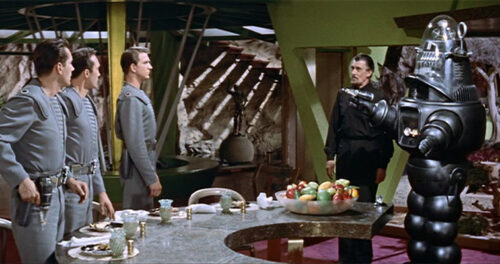[7]
Walter Pidgeon and Leslie Nielsen star in this glossy MGM production about a starship crew investigating a planet where a colony of humans has gone mysteriously quiet. Once there, they discover most of the colonists were killed by a mysterious force. But a scientist (Pidgeon) and his daughter (Anne Francis) appear to be immune to the dangerous entity. Pidgeon shares with the team’s captain (Nielsen) everything he knows about the now-extinct civilization that once thrived on the planet, including a great machine they created — but what does it do? As the invisible adversary begins killing Nielsen’s crew, solving the mystery becomes everyone’s only hope of escape.
Forbidden Planet was MGM’s attempt to bring science-fiction out of the low-budget, black & white doldrums and into widescreen, full-color, A-picture status. The cast takes the material seriously and Cyril Hume’s screenplay is much headier than standard matinee fare. At times, the film is maybe a little too esoteric, but scenes involving a love triangle between Nielsen, Francis and another officer help anchor the yarn in good old fashioned human emotions. The ship’s cook also has some humorous interactions with Pidgeon’s mechanical creation, the iconic Robby the Robot.
What I like most about Forbidden Planet is how it succeeds in whisking us away to another time and place — an early attempt at what Hollywood now calls “world-building”. The film is exotic, with no scenes on Earth or anywhere familiar, and odd sound effects in place of any traditional scoring. The art design might reek of the 50s, but that’s part of the film’s charm. There’s a nice escapist value to the movie, both viscerally and even romantically, with the all-male space crew vying for the attention of the only female (Francis) they’ve met in over a year. The third act also delivers the goods with a satisfying resolution to the mystery, and some nifty ways of depicting the film’s invisible monster.
Oscar Nomination: Best Special Effects

